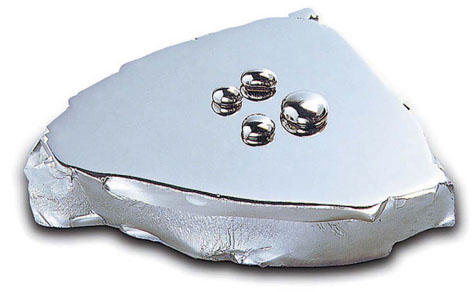Apple has been granted its first patent related to Liquidmetal, a space-age metal alloy. But the patent isn’t for a new iPad enclosure or iPhone antenna, as experts have predicted. Instead Apple’s Liquidmetal patent is for an internal component of a fuel cell.
Apple’s new patent describes “amorphous alloy” collector plates for fuel cells, an electrochemical battery that uses hydrogen to generate electricity. Although the patent doesn’t reference the Liquidmetal trademark, the material is an amorphous alloy or “metallic glass.”
Last year, Apple signed an exclusive agreement to use the Liquidmetal Technologies’ IP in consumer electronic products. But of course, the ever-secretive company hasn’t hinted at its plans for the material. The possibilites are endless. Liquidmetal is a super lightweight, high-strength, scratch-proof metal that NASA says is “poised to redefine materials science as we know it in the 21st century.”
Scientists who helped develop Liquidmetal have previously predicted that Apple will use it to build the next iPhone. So why is Apple interested in fuel cells?

Fuel cells are a hot technology in Silicon Valley right now. The technology promises to be cheap, efficient and environmentally friendly.
Miniature fuel cells could power mobile phones for more than 30 days without recharging and notebooks for 20 hours or more.
Bloom Energy has developed larger fuel cells capable of powering homes and offices. The company, profiled by 60 Minutes, has raised $400 million and sold power units to Google, eBay and Walmart.
The problem is manufacturing fuel cells that are a safe, hard-working and reliable over many years. Lots of companies are working on developing the right materials. Because Liquidmetal can be made to be super hard, corrosion proof, and durable, it may prove to be the ideal material for fuel cells.
The collector plate described in Apple’s patent acts as a catalyst for a chemical reaction that separates electrons from hydrogen to produce electricity. Its only byproducts are water and heat. As long as the cell is topped-up with fuel, it will continue to generate power. The process is clean, quiet and highly efficient — up to three times more efficient than burning fuel.
Apple fuel cell rumors go back to 2003, when the company was rumored to be pursuing fuel cells for PowerBooks.
![Apple Is Granted Its First Liquidmetal Patent [Exclusive] fuel_cell_phone1.jpg](https://www.cultofmac.com/wp-content/uploads/2011/01/fuel_cell_phone1.jpg)

